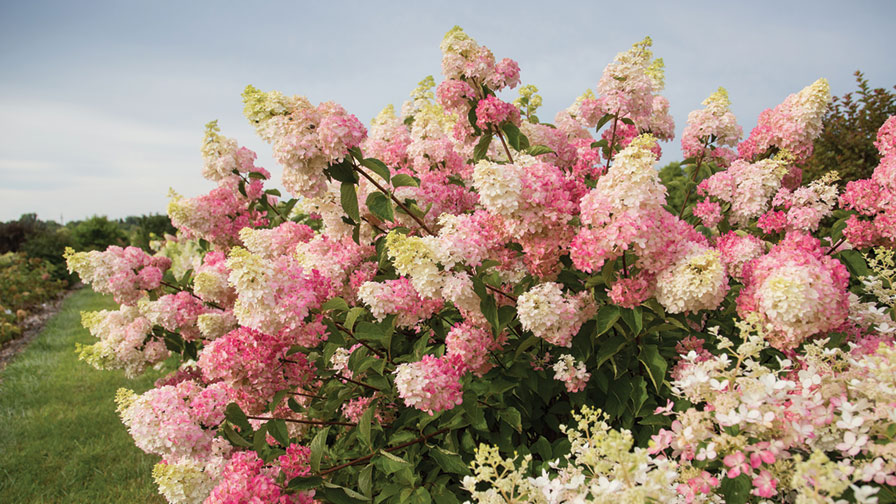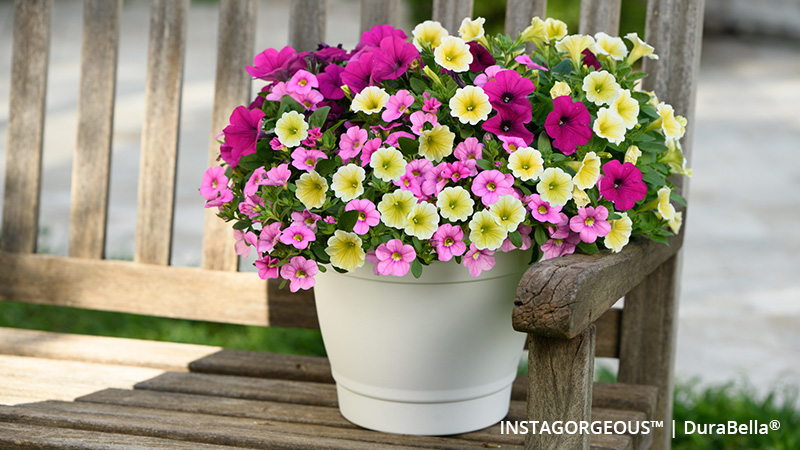Woody Ornamentals Market Set for Growth

Consumers still want lots of color in their shrubs, not only in the massive blooms they crave, but also in foliage with seasonal color interest. Pictured: New Hydrangea ‘First Editions Berry White’ (Bailey Nurseries)
After the economic crisis of 2008, woody ornamental growers remain cautious about what they put in the ground. The general sense is that the shrub market is stable, but somewhat static. However, an uptick in the housing market is starting to contribute to market growth. To keep the momentum going, the industry will need to stay on top of trends and educate for consumer success.
“Consumer confidence appears to be higher, and the spend at retail is higher per transaction,” says Todd Carnley, Vice President of Sales and Marketing at Flowerwood Nursery. “The housing market has improved and the professional side (landscape and re-wholesale) of our business is trending upward.”
Going forward, tried-and-true genetics will be just as important to continued growth in the market as new genetics, says Marc McCormack, Director of Sales and Marketing at Bailey Nurseries. Just because a plant isn’t brand new, it shouldn’t be excluded from marketing efforts if it is a reliable performer and a good seller.
Ordinary Shrubs Won’t Fetch Profits Anymore
In a mature woody ornamentals market, the biggest question on everyone’s mind is how to capture a bigger slice of the market pie. Next to longer-lasting, more impressive blooms, product differentiation may be the key to increased sales to consumers bored with commonplace shrubs. This may not necessarily be brand-new varieties, as much as unique items that play to the trends and offer more value.
“Consumers don’t want cookie-cutter stuff anymore, especially Millennials,” says Jonathan Pedersen, Vice President of Business Development for Monrovia. “They want something their neighbors don’t have – something unique.”
Carnley says branded items that are truly unique are selling well at Flowerwood. Millennials tend to decorate more with shrubs but are less apt to grow simple boxwood-type hedges. They like to mix and match colors and textures.
Mark Sellew, President of Prides Corner Farms in Lebanon, CT, says he has noticed that broadleaf plants like rhododendron and boxwoods are doing well at his business, while sales of generic flowering shrubs are in decline. The pollinator crisis has also lifted the native plant category considerably at the independent garden center level and on the commercial landscape side.
Easy to grow, edible shrubs are beginning to stand out in the market because they fit in with the popular grow-your-own-food movement. Shannon Downey, Public Relations and Marketing Specialist for Spring Meadow Nursery, says she thinks we’ll see more landscapes that mix edibles and ornamentals. To meet the need, Spring Meadow has introduced items like ‘Instant Karma’ elderberries, known for their ornamental qualities and edible fall berries, and Yezberry haskaps, which are easier to grow than blueberries.

Edible shrubs such as Yezberry haskaps (Spring Meadow Nursery), which is easier to grow than blueberries, are growing in popularity.
Kip McConnell, Director of Plant Development Services, which oversees the Encore Azalea brand and the Southern Living and Sunset Western Plant Collections, says interest in edible ornamental landscaping keeps growing. Compact edibles, such as a new dwarf pineapple guava and a compact fruiting pomegranate his company will soon be introducing, dovetail into the trend toward small-space gardening.
As consumers’ allotted garden space shrinks, compact varieties are replacing large, sprawling shrubs. Gardeners want smaller, upright plants that still afford them privacy. As a result, breeders are looking closely at not only dwarf varieties, but also those that offer garden height. Containers go hand-in-hand with small-space gardening, and shrubs are playing a role here, side-by-side with annuals, perennials, and grasses.
“We have sold a few plants to other growers using them in combination with annuals for containers. I believe this market will continue to grow; we just have to do a better job of marketing the right plants that will thrive in this environment and also in some cases get past the mixed container idea and look at the multiple season appeal some shrubs have on their own,” says Chris McCorkle, Operations Manager at McCorkle Nurseries. “I think we try to over complicate some containers and fail to consider the longer term life potential.
While shrub use in containers is increasing, industry experts say this trend has been slower to catch on than others have, mainly in part because it can be difficult to convince customers that shrubs can actually thrive in containers.
Education Must Go Hand-in-Hand With Sales
The false notion that shrubs don’t make good container plants is a prime example of the need for more education, to build awareness that uses for shrubs go beyond traditional foundation plantings and to empower consumers to make woody ornamental purchases they feel confident about growing successfully.
“I think that well-tested, distinctively positive new plants will drive growth, but so will making buying plants easier on new consumers and marketing plants in new ways,” says Pete Kruger, Director of Product Development and Licensing at Star Roses and Plants.
Monrovia takes the guesswork out of growing woody ornamentals by providing detailed plant information on its tags that includes suggestions for how to use the plants. Text codes on the tags push customers to Monrovia’s website for extended information, and while consumers are there, they can access how-to videos and get design inspiration.
Pedersen says Monrovia is focusing more on how-to videos to show consumers new ways to use shrubs. For example, Monrovia created a video series geared toward younger consumers that showed them how to upscale their house without having to redo their landscape by using evergreen shrubs in window boxes.
Bailey Nurseries rolled out a redesigned tag for its Endless Summer hydrangea collection that is more contemporary and communicates more clearly what the brand has to offer. Photos on the tag make it easier for consumers to tell what they are getting, even when the plant isn’t in bloom. The text code appears more prominently on the tag, to direct consumers to regionally based plant care information through Bailey’s “Plants that text you back” campaign.
Bailey Nurseries, along with other breeders and growers, is striving to make consumers more aware of plant categories previously unknown to them. For example, McCormack says 10 years ago the trade and consumers didn’t know much about distyllium in the U.S., and now it is one of Bailey’s best-selling plants online, thanks to its “Greatest Plant You Never Heard Of” marketing campaign.










